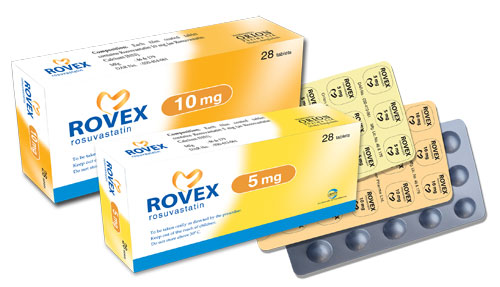

Rovex 5 Tablet: Each film coated tablet contains Rosuvastatin Calcium INN equivalent to 5 mg Rosuvastatin.
Rovex 10 Tablet: Each film coated tablet contains Rosuvastatin Calcium INN equivalent to 10 mg Rosuvastatin.

INN

Lipid Lowering Drug

Heterozygous Hypercholesterolemia (Familial and Nonfamilial)
Homozygous Hypercholesterolemia (Familial)
Mixed Dyslipidemia (Fredrickson Type IIa and IIb)

Rosuvastatin is contraindicated if-

Heterozygous Hypercholesterolemia (Familial and Nonfamilial) and Mixed Dyslipidemia (Fredrickson Type IIa and IIb)
The usual recommended starting dose of Rosuvastatin is 10 mg once daily. Initiation of therapy with 5 mg once daily may be considered for patients requiring less aggressive LDL-C reductions or who have predisposing factors for myopathy. For patients with marked hypercholesterolemia (LDL-C > 190 mg/dL) and aggressive lipid targets, a 20 mg starting dose may be considered. The 40 mg dose of Rosuvastatin should be reserved for those patients who have not achieved goal LDL-C at 20 mg. After initiation and/or upon titration of Rosuvastatin, lipid levels should be analyzed within 2 to 4 weeks and dosage adjusted accordingly.
Homozygous Hypercholesterolemia (Familial)
The recommended starting dose of Rosuvastatin is 20 mg once daily in patients with homozygous FH.The maximum recommended daily dose is 40 mg. Rosuvastatin should be used in these patients as an adjunct to other lipid-lowering treatments (e.g., LDL apheresis) or if such treatments are unavailable.

Rosuvastatin is generally well tolerated. The adverse events seen with Rosuvastatin are generally mild and transient. Most commonly occurring side-effects are headache, myalgia, asthenia, constipation, dizziness, nausea, abdominal pain. Uncommonly pruritus, rash and urticaria may occur. Myopathy (including myositis), hypersensitivity reactions (including angioedema), rhabdomyolysis, pancreatitis etc are the rarely occurring side-effects of Rosuvastatin.

Caution should be taken in patients with thyroid problem, have family history of muscular disorder, had any past problems with muscles (pain, tenderness), after using an HMG-CoA reductase Inhibitor (statin) such as atorvastatin, fluvastatin, lovastatin, pravastatin or simvastatin or have developed an allergy or Intolerance to them.

Erythromycin: Co-administration of Erythromycin with Rosuvastatin decreased AUC and Cmax of Rosuvastatin. Itraconazole: Itraconazole increases the AUC of Rosuvastatin. Fluconazole: Co-administration of Fluconazole with Rosuvastatin increases the AUC of Rosuvastatin. Warfarin: The pharmacokinetics of Warfarin is not significantly affected following co-administration with Rosuvastatin. Cyclosporin: Co-administration of Rosuvastatin with cyclosporin resulted in no significant changes in Cyclosporin plasma concentration. Gemfibrozil: Concomitant use of Rosuvastatin and Gemfibrozil resulted in a two-fold increase in Cmax and AUC. Antacid: The simultaneous dosing of Rosuvastatin with an antacid suspension containing Aluminium and Magnesium hydroxide resulted in a decrease in Rosuvastatin plasma concentration of approximately 50%. There are no clinically significant interactions with an oral contraceptive, Digoxin, Fenofibrate, antihypertensive agents, antidiabetic agents and hormone replacement therapy.

Patients with renal insufficiency
No modification of dosage is necessary for patients with mild to moderate renal insufficiency. For patients with severe renal impairment (CLcr<30 mL/min/1.73 m2) not on hemodialysis, dosing of Rosuvastatin should be started at 5 mg once daily and not to exceed 10 mg once daily.
Dosage in Asian Patients
In Asian patients, consider initiation of Rosuvastatin therapy with 5 mg once daily due to increased Rosuvastatin plasma concentrations. The increased systemic exposure should be taken into consideration when treating Asian patients not adequately controlled at doses up to 20 mg/day.
Use with Cyclosporine, Lopinavir/Ritonavir or Atazanavir/Ritonavir
In patients taking Cyclosporine, the dose of Rosuvastatin should be limited to 5 mg once daily. In patients taking Lopinavir and Ritonavir or Atazanavir and Ritonavir the dose of Rosuvastatin should be limited to 10 mg once daily.

Rosuvastatin can be administered to pediatric patients 10 to 17 years of age with heterozygous familial hypercholesterolemia to reduce elevated total-C, LDL-C and ApoB after failing an adequate trial of diet therapy.

Rosuvastatin should be administered to women of childbearing age only when such patients are highly unlikely to conceive and have been informed of the potential hazards. If the patient becomes pregnant while taking this drug, therapy should be discontinued immediately. It is not known whether Rosuvastatin is excreted in human milk.

There is no specific treatment in the event of overdose. In the event of overdose, the patient should be treated symptomatically and supportive measures instituted as required. Liver function and CK levels should be monitored. Hemodialysis is unlikely to be of benefit.

Do not store above 25°C. Keep away from light and moisture. Keep all medicines out of the reach of children.
© 2025 Orion Pharma Ltd. All rights reserved.